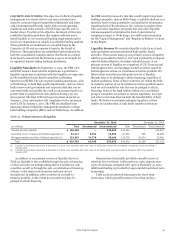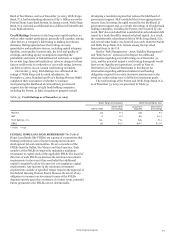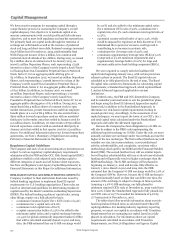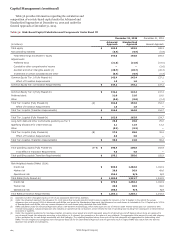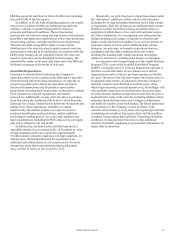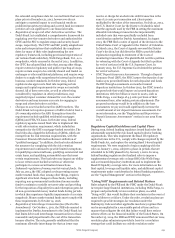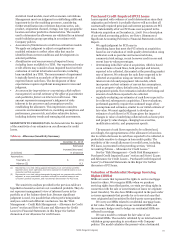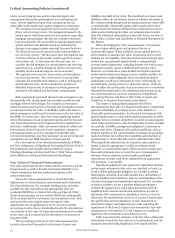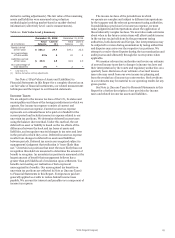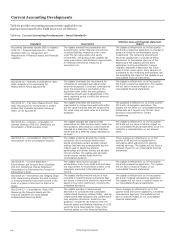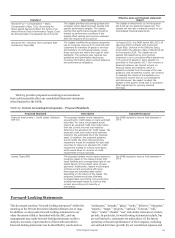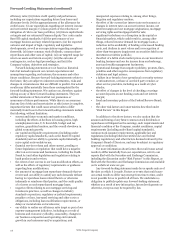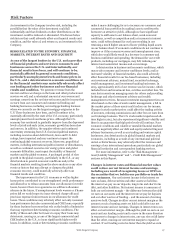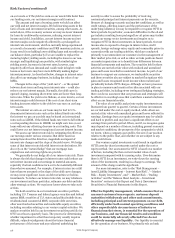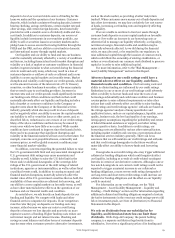Wells Fargo 2015 Annual Report Download - page 111
Download and view the complete annual report
Please find page 111 of the 2015 Wells Fargo annual report below. You can navigate through the pages in the report by either clicking on the pages listed below, or by using the keyword search tool below to find specific information within the annual report.the extended compliance date for covered funds that were in
place prior to December 31, 2013, however we do not
anticipate a material impact to our financial results as
prohibited proprietary trading and covered fund investment
activities are not significant to our financial results.
• Regulation of swaps and other derivatives activities. The
Dodd-Frank Act established a comprehensive framework for
regulating over-the-counter derivatives and authorized the
CFTC and the SEC to regulate swaps and security-based
swaps, respectively. The CFTC and SEC jointly adopted new
rules and interpretations that established the compliance
dates for many of their rules implementing the new
regulatory framework, including provisional registration of
our national bank subsidiary, Wells Fargo Bank, N.A., as a
swap dealer, which occurred at the end of 2012. In addition,
the CFTC has adopted final rules that, among other things,
require extensive regulatory and public reporting of swaps,
require certain swaps to be centrally cleared and traded on
exchanges or other multilateral platforms, and require swap
dealers to comply with comprehensive internal and external
business conduct standards. In October 2015, federal
regulators also approved a final rule requiring certain
margin and capital requirements for swaps not centrally
cleared. All of these new rules, as well as others being
considered by regulators in other jurisdictions, may
negatively impact customer demand for over-the-counter
derivatives and may increase our costs for engaging in
swaps and other derivatives activities.
• Changes to asset-backed securities (ABS) markets. The
Dodd-Frank Act requires sponsors of ABS to hold at least a
5% ownership stake in the ABS. Exemptions from the
requirement include qualified residential mortgages
(QRMs) and FHA/VA loans. In October 2014, federal
regulatory agencies issued final rules to implement this
credit risk retention requirement, which included an
exemption for the GSE’s mortgage-backed securities. The
final rules also aligned the definition of QRMs, which are
exempt from the risk retention requirements, with the
Consumer Financial Protection Bureau’s definition of
“qualified mortgage.” In addition, the final rules addressed
the measures for complying with the risk retention
requirement and continued to provide limited exemptions
for qualifying commercial loans, qualifying commercial real
estate loans, and qualifying automobile loans that meet
certain requirements. The final rules may impact our ability
to issue certain asset-backed securities or otherwise
participate in various securitization transactions.
• Enhanced regulation of money market mutual funds. On
July 23, 2014, the SEC adopted a rule governing money
market mutual funds that, among other things, requires
significant structural changes to these funds, including
requiring non-governmental institutional money market
funds to maintain a variable net asset value and providing
for the imposition of liquidity fees and redemption gates for
all non-governmental money market funds during periods
in which they experience liquidity impairments of a certain
magnitude. Money market mutual funds must comply with
these requirements by October 14, 2016.
• Regulation of interchange transaction fees (the Durbin
Amendment). On October 1, 2011, the FRB rule enacted to
implement the Durbin Amendment to the Dodd-Frank Act
that limits debit card interchange transaction fees to those
reasonable and proportional to the cost of the transaction
became effective. The rule generally established that the
maximum allowable interchange fee that an issuer may
receive or charge for an electronic debit transaction is the
sum of 21 cents per transaction and 5 basis points
multiplied by the value of the transaction. On July 31, 2013,
the U.S. District Court for the District of Columbia ruled
that the approach used by the FRB in setting the maximum
allowable interchange transaction fee impermissibly
included costs that were specifically excluded from
consideration under the Durbin Amendment. In August
2013, the FRB filed a notice of appeal of the decision to the
United States Court of Appeals for the District of Columbia.
In March 2014, the Court of Appeals reversed the District
Court’s decision, but did direct the FRB to provide further
explanation regarding its treatment of the costs of
monitoring transactions. The plaintiffs did not file a petition
for rehearing with the Court of Appeals but filed a petition
for writ of certiorari with the U.S. Supreme Court. In
January 2015, the U.S. Supreme Court denied the petition
for writ of certiorari.
• FDIC Deposit Insurance Assessments. Through a Deposit
Insurance Fund (DIF), the FDIC insures the deposits of our
banks up to prescribed limits for each depositor and funds
the DIF through assessments on member insured
depository institutions. In October 2015, the FDIC issued a
proposed rule that would impose on insured depository
institutions with $10 billion or more in assets, such as
Wells Fargo, a surcharge of 4.5 cents per $100 of their
assessment base, after making certain adjustments. The
proposed surcharge would be in addition to the base
assessments we pay and could significantly increase the
overall amount of our deposit insurance assessments. For
more information, see the “Regulation and Supervision –
Deposit Insurance Assessments” section in our 2015 Form
10-K.
Regulatory Capital Guidelines and Capital Plans
During 2013, federal banking regulators issued final rules that
substantially amended the risk-based capital rules for banking
organizations. The rules implement the Basel III regulatory
capital reforms in the U.S., comply with changes required by the
Dodd-Frank Act, and replace the existing Basel I-based capital
requirements. We were required to begin complying with the
rules on January 1, 2014, subject to phase-in periods that are
scheduled to be fully phased in by January 1, 2022. In 2014,
federal banking regulators also finalized rules to impose a
supplementary leverage ratio on large BHCs like Wells Fargo
and our insured depository institutions and to implement the
Basel III liquidity coverage ratio. For more information on the
final capital, leverage and liquidity rules, and additional capital
requirements under consideration by federal banking regulators,
see the “Capital Management” section in this Report.
“Living Will” Requirements and Related Matters
Rules adopted by the FRB and the FDIC under the Dodd-Frank
Act require large financial institutions, including Wells Fargo, to
prepare and periodically revise resolution plans, so-called
“living-wills”, that would facilitate their resolution in the event of
material distress or failure. Under the rules, resolution plans are
required to provide strategies for resolution under the
Bankruptcy Code and other applicable insolvency regimes that
can be accomplished in a reasonable period of time and in a
manner that mitigates the risk that failure would have serious
adverse effects on the financial stability of the United States. On
November 25, 2014, the FRB and FDIC announced that our 2014
resolution plan submission provided a basis for a resolution
strategy that could facilitate an orderly resolution under
Wells Fargo & Company
109


